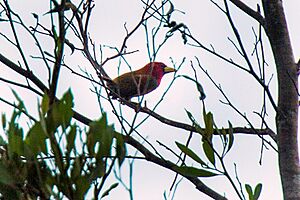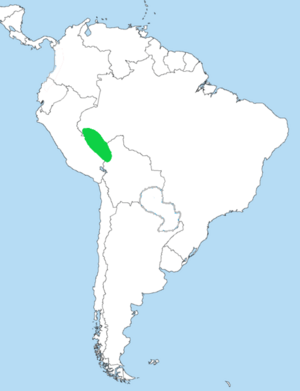Scarlet-hooded barbet facts for kids
Quick facts for kids Scarlet-hooded barbet |
|
|---|---|
 |
|
| Conservation status | |
| Scientific classification | |
| Genus: |
Eubucco
|
| Species: |
tucinkae
|
 |
|
The scarlet-hooded barbet (scientific name: Eubucco tucinkae) is a colorful bird. It belongs to a group of birds called New World barbets. You can find this bird in parts of Bolivia, Brazil, and Peru.
Contents
About the Scarlet-hooded Barbet
The scarlet-hooded barbet is a unique bird. It is considered monotypic. This means it is the only species in its group, and it does not have any subspecies. Scientists once thought it might be related to the red-headed barbet. However, they now know it is a separate species. It does not have any very close relatives, even within its own bird family.
What Does the Scarlet-hooded Barbet Look Like?
This bird is about 17 cm (6.7 in) long. It weighs between 40 to 44 g (1.4 to 1.6 oz). That is about the same weight as a few pieces of candy!
Male Scarlet-hooded Barbet
The male bird has a bright red head, throat, and upper back. It has a small amount of black around its eyes and beak. The rest of its upper body is green. Its lower chest is orange and yellow. It also has a gray patch on its side. The feathers on its sides have olive-colored stripes.
Female Scarlet-hooded Barbet
Most of the female's head is also red. However, her throat is yellow instead of red. She has an orange band across her upper chest. The rest of her lower body looks similar to the male's.
Where the Scarlet-hooded Barbet Lives
The scarlet-hooded barbet lives in the upper Amazon Basin. This area is where eastern Peru, western Brazil, and a small part of western Bolivia meet. More than half of these birds live in Peru.
Habitat of the Scarlet-hooded Barbet
These birds like to live in dense forests. They especially like areas with bamboo and Heleconia plants. They are almost always found within 150 m (490 ft) of rivers and oxbow lakes. You might also see them in overgrown gardens near rivers. They can also be found on islands in rivers. They live at elevations from about 150 to 850 m (490 to 2,790 ft) above sea level.
How the Scarlet-hooded Barbet Behaves
What the Scarlet-hooded Barbet Eats
The scarlet-hooded barbet eats a mix of foods. About 60% of its diet is fruits. This includes fruits like figs and Cecropia seeds. The other 40% of its diet is insects and other arthropods. It also eats flowers and their sweet nectar.
This bird looks for food from near the ground up to about 11 m (36 ft) high. It picks fruits from branches. It also pokes around in dead leaves to find insects. Sometimes, it joins groups of different bird species that are all looking for food together. These are called mixed-species foraging flocks.
Reproduction and Life Cycle
The scarlet-hooded barbet builds its nests in Peru. They have been seen nesting in July. Like all New World barbets, they dig a hole to make their nest. They usually make this hole in a tree. However, scientists do not know much else about how they raise their young.
Scarlet-hooded Barbet Sounds
The song of the scarlet-hooded barbet is a fast "oop-oop-oop-". You can listen to its song online here.
Conservation Status
The IUCN (International Union for Conservation of Nature) has looked at the scarlet-hooded barbet. They have decided that it is a species of "Least Concern". This means that it is not currently in danger of disappearing. However, more information is needed about its nesting habits. Scientists want to learn more about what the bird needs to survive and thrive.


